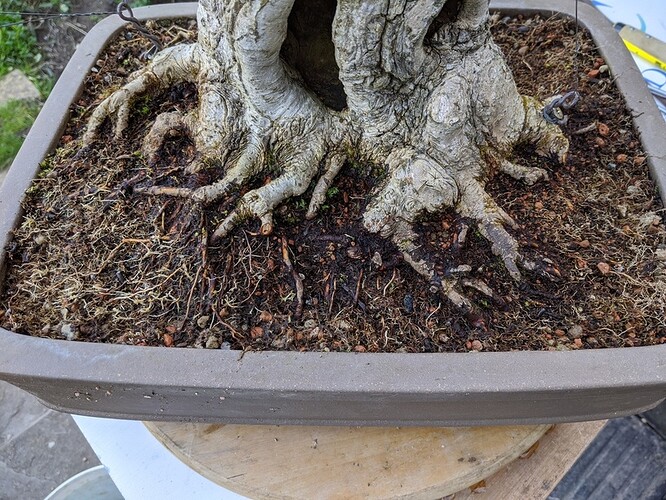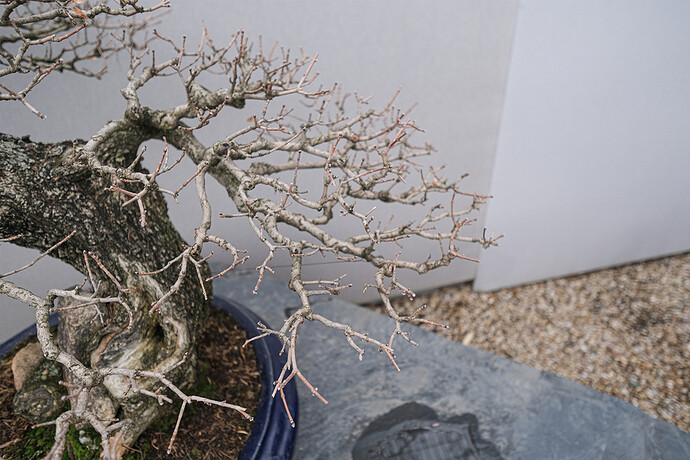For those of you that have Acer campestre in refinement, do you find that pinching out emerging buds is an effective technique as with Acer palmatum? I’ve taken a few different approaches over the years, but I really want to get the finest growth possible this year. I will be carefully controlling fertilisation, re-potting less often, running out sap-draws and performing partial defoliation.
Alongside these techniques I can either pinch or allow extension and then prune back, but I am yet to decide which achieves the finest internodes, twigging and ramification in this species. Do any of you have experience with refinement of this species?
I can’t answer your question as its’ the same question I have. Friends have advised extend and prune back and I believe this is better for overall health and vigour. Pinching IMHO would probably be better for ramification but I can’t be sure until I’ve tried it. Last year I got it all wrong getting massive extension and ended up having to prune back completely, gaining nothing in the process except experience. I shall watch this with interest to see what others advise.
Likewise, I can’t answer, but I’d also like to know. Observing my Campestres I’d say almost certainly the answer would be “yes” to pinching at refinement. While in development I withhold all fertilisation during the spring push and cut back to 1 internode as soon as the leave harden off.
Perhaps your question would be worth asking at Live Q&A. Do you have access to that @Silva_Naturalis?
@Ralph unfortunately I don’t have premium membership, not can I afford it safely, but it’s certainly a question I’d be keen to hear an answer to. As you know I’m getting some refinement, but I’m keen to do better. I’m going to trail pinching (unless I hear persuasively to the contrary) for the next couple of years, particular in light of listening to the 2nd Asymmetry podcast with Denis Vojtilla. I will certainly report back.
This afternoon I’m cleaning and refining surface roots on the most refined of my A. campestre. Removed moss (and a creeping weed that’s has insinuated itself with the tree roots), scraping out organic matter back to substrate, removing some crossing roots, etc. Satisfying detailed work, which feels like the best thing to do in lieu of repotting. I’ve used a gentle jet spray (using a pump up 5ltr spraying bottle with a lance) to wash of the surface after the first rough cleaning, allowing me to see detailed structure. It’s important to steeply angle the pot with a block when you do this, so as not to wash the mud into the pore spaces of the tree.
hi, good nebari ! 
I have some Acer campestre in development, if I were you i would pinch every day at least for two weeks and no fertilizer before may.
what soil do you use ?
Thanks
@Eros93 thanks! This tree is in circa 60% moller clay, 15% coconut husk chips (I’m moving to.pine bark this year, but only because I can’t get the right grade of the former) and 25% pumice.
@Ralph (excuse weird typos in my former reply, I was somewhat distracted and can no longer edit)
Both the Dennis Vojtilla podcasts are gold. I will try pinching on one of my field maples too. But I’ll also try and ask on a Live Q&A to get Ryan’s thoughts too – he as at least one field maple.
It would be interesting to hear Ryan’s thoughts, I have several different A. campestre in development, including a forest, so I’ll mix up the techniques a bit and see what works best. Wish I’d been more systematic and recorded my processes better, I could have worked it out by now!
Cracking nebari! And the heavy callus rolling in on the large uro is very nice ![]() . Did you ever graft roots to improve the nebari? Good point about steeply angling the pot so the fine organics wash off rather than in.
. Did you ever graft roots to improve the nebari? Good point about steeply angling the pot so the fine organics wash off rather than in.
Funny thing is I was working this afternoon on one of my Campestres in development. Repot + reducing long thick roots and thread & approach grafting some smaller roots. Early days. Many years to go before it’s anywhere near as developed as yours.
Hi Matt,
I’m a few years away from refining my field maples, but I’ve already used the pinching on other maples (pseudoplatanus, palmatum, platanoides, rubrum) and it has always reduced both leaf size and internodes in my experience.
For what it is worth, the field maple reputation is that it doesn’t lend itself to really fine ramification like you’d see on palmatum but will always remain a bit rougher.
@Ralph nice to see something of your trunk in development. I did graft a few roots with approach grafts about 8 years ago, but most of the nebari was grown by very slowly raising the planting depth user by year and careful root pruning, plus shaving the underside of the trunk at each repotting.
@Michael_P of course, one could never expect the fine ramification of Acer palmatum, but I love working with native species and I’ve got a special place in my heart for filed maple. It’s interesting to hear you’ve had consistent success with pinching Acer’s other than palmatum.
Sorry, but why don’t use akadama in the mix ?
@Eros93 I find Akadama to be expensive in the UK (it’s a long way to Japan after all, so it has a right to be), and it is not so superior as to merit the cost for me. Furthermore, it breaks down very quickly in the intense wet and freeze-thaw cycles of a British winter.
As our only truly native maple (UK) we don’t have many other options ![]() , if you prefer working with native species that is. Plus, although it has that reputation, I look forward to attempting to get ramification as fine as possible on Camestre. As I understand it’s a similar situation (about the coarseness) with the Montpellier maple (Acer monspessulanum), but when you do occasionally see a well-ramified example, it’s certainly lovely. Interesting to know about your successes with pinching pseudoplatanus, platanoides and rubrum, thanks.
, if you prefer working with native species that is. Plus, although it has that reputation, I look forward to attempting to get ramification as fine as possible on Camestre. As I understand it’s a similar situation (about the coarseness) with the Montpellier maple (Acer monspessulanum), but when you do occasionally see a well-ramified example, it’s certainly lovely. Interesting to know about your successes with pinching pseudoplatanus, platanoides and rubrum, thanks.
When I visited Luis Vallejo’s museum in Alcobendas in December I took a few photos of his Campestre, which showed delicate branch structure (for a field maple). A few photos of it below.
Don’t get me wrong… I love campestre and I’m currently trying to make a shohin out of a nursery-bought one.
Patrice Bongrand had a beautiful specimen he trained from a nursery tree chopped down to 80cm in 1996. Twelve years later, the tree was 1 meter tall with its new apex and tertiary ramification in place. His recommendation on campestre was to let it grow, then cut back… and only pinch terminal growth after leaf extension if there were new shoots behind it. His experience was that Japanese-style shoot pinching before complete leaf extension weakened the local species too much. It may have been related to his specific growing conditions in the Pyrenees.
@Ralph indeed! Interesting to see that specimen, I think careful dosing and timing of fertilisation is going to be key to get those fine twigs.
Also, as with many species, both Acer campestre and Acer monspessulanum show significant phenotypic variation (bud shape, angle, propensity to back bud, production of bark, etc). I have quite a bit of variation even in my small collection. I even have a twin trunk I’m working on, fused from two saplings collected within a metre of each other) which I noticed today has red buds on one trunk and green on the other.
I collected an Acer seedling when walking in the Massif Central with my French pals which I hope is monspessulanum (bark and buds are distinct).
@Michael_P all species have their own challenges and joys of course, don’t worry I didn’t think you were damning A. campestre 
Interesting about Patrice Bongrand’s observations, it’s certainly worth being mindful of. You’re right, local climatic variations (and indeed species variants) could play a big role with what works.





